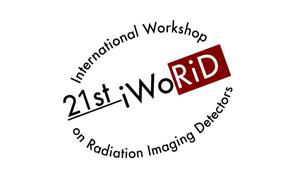Speaker
Description
The DSSC 1-Megapixel Camera was developed for photon science applications in the energy range between 0.25 keV and 6 keV at the European XFEL in the Hamburg area in Germany. The first complete 1 Megapixel DSSC camera [1] is now available (see Figure 1), fully tested and installed at the Spectroscopy and Coherent Scattering (SCS) instrument. The detector system is at the moment the fastest existing 2D camera for soft X-rays.
The recently assembled camera operates at a maximum frame rate of 4.5 MHz and allows one to cope with the very demanding pulse time structure of the European XFEL: bursts with 2700 pulses spaced by 220 ns at a rate of 10 Hz.
The DSSC detector is based on Si-sensors and is composed of 1024 x 1024 hexagonal pixels for a total active area of 210 x 210 mm^2. The pixel arrays are subdivided into 16 ladders with 128 × 512 pixels each. Every detector ladder is bump-bonded to mixed signal readout ASICs [2]. The ASICs, comprising 64 x 64 channels, are designed in 130 nm CMOS technology and provide full parallel readout of the sensor pixels. Each ASIC channel is composed of an analog trapezoidal filter, a 8-bit ADC and an SRAM able to store up to 800 frames per bunch train. The detector is able to overwrite selected images stored in the memory in real-time, in case an event is tagged as non-valid by a veto signal provided by the XFEL machine.
The camera head electronics has to cope with a total data transfer of 144 Gbit/s for the 1-mega-pixel device.
This first mega-pixel camera is equipped with linear MiniSDD pixel arrays. Even if this sensor technology can provide only limited dynamic range, it has a very low noise level of around 70 el. rms at the full speed of 4.5 mega-frames/second. This performance has been demonstrated on the complete camera using a lab pulsed X-ray source and will be shown for the first time during this talk.
The challenge of having high-dynamic range (up to ~ 10^4 photons/pixel/pulse) and single photon detection simultaneously requires a non-linear response of the system front-end. This will be implemented in the second version of the DSSC camera. In fact, the entire DSSC system is designed in order to be compatible with both types of pixelated sensors, MiniSDD and DEPFET.
The ultimate performance is expected operating the DSSC camera with the DEPFET [3] pixel arrays that provide lower noise figures and signal compression at the sensor level. This allows one to achieve a dynamic range of several thousand photons at 1 keV, keeping at the same time single photon sensitivity.
At this stage of the project the complete camera has been tested, calibrated and is being installed at the SCS photon beamline. The first users’ experiment of X-ray holography using ~700 eV photons is foreseen by the end of May and it will be completed by the time of the talk.
We will give an overview of the DSSC system with its main components with special focus to the first results obtained with the first full Megapixel camera.
We will shortly discuss the realization of the second DEPFET-based DSSC camera. Results on DEPFET devices produced for the first time in a CMOS foundry will be shown together with the performance of the newly designed DEPFET version of the improved readout ASIC.
References
[1] M. Porro et al., IEEE TNS , vol.59, no.6, pp.3339,3351, Dec. 2012;
[2] P. Fischer et al., NSS Conference Record (NSS/MIC), 2010 IEEE, Nov. 2010, pp. 336 –341
[3] S. Aschauer et al., Journal of Instrumentation, Volume 12, November 2017.
